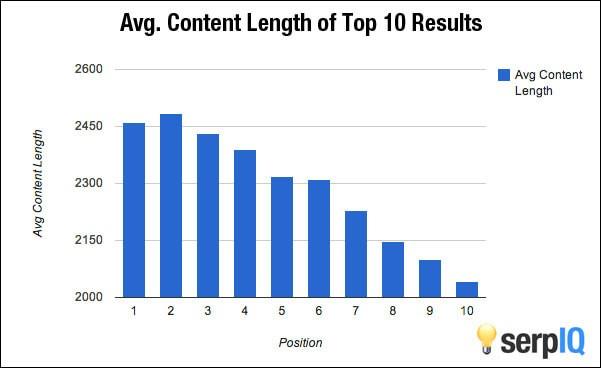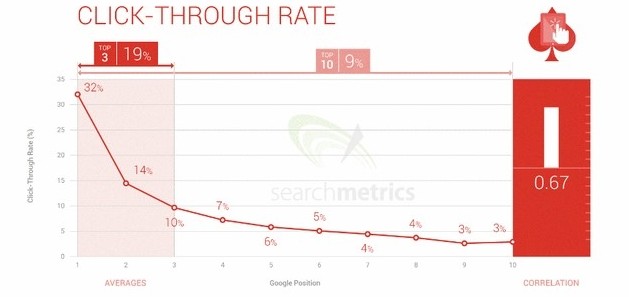Search engines help you get new readers, viewers, and listeners for your content, but all too often you yourself are the reason search engines hold your content back from prominent positions in their search results pages.
Search engines want to show the world your content, but not if you’ve made mistakes that undermine the user experience and search engines’ guidelines.
So give the search engines what they want by avoiding the following common mistakes that content creators make.
1. Short Content
Google likes long-form content because it gives searchers enough information to satisfy their needs. Generally, the more in-depth the content is, the more likely it solves the searcher’s intent or question, and that is what Google wants.
A SerpIQ study found that content shown in Google search results in positions 1-3 had around 2,400 words, on average. In short, long-form content ranked better in Google.
Does this mean you should be writing long for the sake of long? No, but you do want to make sure your content is comprehensive enough to answer searchers’ questions.
A good approach for each piece of content you plan to produce is to determine the main keyword phrase. Then google that phrase to see how long the content is in the top 3 search results. Make sure your own content is longer, more in-depth, more concise, and more well-thought-out. If you do, readers as well as Google will think more highly of your content.
2. No Imagery or Design Elements
No one likes stale websites that look like they were put up in 1999; new, modern-looking websites simply perform better. Content is the same: If you have pages of text with no imagery or design elements, then readers—and therefore Google—will not favor your content over your competitors’.
Design elements that break up text keeps readers on the page longer. The longer they are on the page, the more likely Google will boost the content’s rank due to dwell time.
Basically, the assumption is that the longer they are on the page, the more likely it’s meeting their needs, which means a better chance to be shared on social media, linked to, or be visited again.
3. Misspellings/Content Errors
Misspellings and other content errors are not, technically, SEO factors, but they hurt your credibility and your chance to be linked to. Acquiring links is one of the best ways to get content to the top of the search results. If you want to know more, Google’s Matt Cutts discusses the issue here.
4. No Content Breaks
The average reader’s attention span is very short—shorter than even than that of a goldfish, apparently. Hence the importance of recapturing the reader’s attention continuously, throughout an article.
To do that, break up the text. Using subheads, lists, and images to break up the content will keep the readers reading and on the page, which, again, will help with getting the content noticed by search engines.
5. Using Long Paragraphs of Text
Similarly, using long paragraphs is a good way to get your readers to leave immediately from your page. The shorter your paragraphs, the better you can get, and keep, the attention of readers—and keep them reading.
Pauline from Twelveskip.com has written a good piece on the benefits of shorter paragraphs:
6. No Outbound Links
Readers want credible content. If your content is merely you doing the “talking” and does not link out to other content (to cite sources, for example), why would the readers find it credible or want to link to you?
Google also recognizes this. A few SEO experiments have discovered that pages with outbound links generally do better in the search process. Is that because content that has outbound links is just generally better, more well-researched content? Absolutely!
Reboot Online did an experiment to see whether outbound links improve ranking in organic search results, and found that they do make an impact. The experiment couldn’t determine how big the impact was, but there was an impact nonetheless.
7. No Promotion
Just because you create content and make it better than everyone else’s does not mean it will go instantly to No. 1. There is a reason SEO takes a while. You have to wait for people to come to your content and give it positive SEO-ranking signals, such as links and social shares.
Those ranking factors could take hours, days, months, or even years. However, if you promote your content, you can get it to the right eyeballs quicker… and so get the ranking signals quicker.
Having a solid promotion strategy is key. (Check out this article of mine on how to promote content via social media.)
8. No Meta Optimization and CTAs
Another mistake is using the default options for your content’s meta information—titles and descriptions. This may be the last of the SEO mistakes I’ve listed, but it’s important; you can, and should, optimize the content title and description; otherwise, Google will use your header and the first two sentences, by default.
Instead, write unique meta titles and descriptions for each of your content. In WordPress, for example, it’s easy to do by using the Yoast SEO plugin—or others.
You also want to grab people’s attention with calls to action (CTAs) in the meta information. If you can grab the searchers’ attention when they see your content in search results, they are more likely to click on it. And clickthrough rate is one of the largest ranking factors, according to Searchmetrics’ 2015 Ranking factor study.
Conclusion
If you look out for these eight common mistakes, and make sure you avoid them, you will be much more successful with organic search traffic to your content. And not coincidentally, you will also be creating some solid content, which will help bring you additional traffic due to positive word-of-mouth and various other channels.
Source: Eight Simple SEO Mistakes Killing Your Content Marketing





Recent Comments